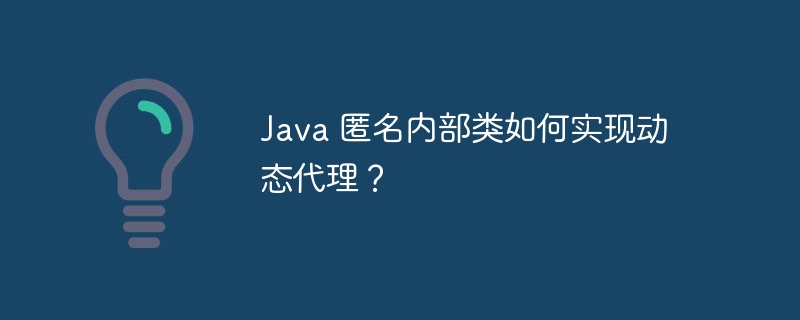How to implement dynamic proxy in Java anonymous inner class?
Anonymous inner classes can be used to implement dynamic proxy in Java, through the following steps: 1. Define the interface; 2. Create an anonymous inner class that implements the InvocationHandler interface; 3. Use the Proxy class to create a proxy object; 4. Call the proxy method. In practice, dynamic proxies can enhance or intercept method calls, such as recording method execution time.

How Java anonymous inner classes implement dynamic proxies
Dynamic proxies are a technology for creating object proxies at runtime , allows enhancing or intercepting object calls without modifying the target class code. Anonymous inner classes can be used to implement dynamic proxies in Java.
1. Define the interface
First, define an interface to represent the method of the target object:
interface Target {
void doSomething();
}2. Create an anonymous inner class
To create a dynamic proxy, you can use an anonymous inner class to implement InvocationHandler Interface:
InvocationHandler handler = new InvocationHandler() {
@Override
public Object invoke(Object proxy, Method method, Object[] args) throws Throwable {
// 增强或拦截方法调用
return 1;
}
};3. Create a proxy object
Next, create a proxy object using the Proxy class:
Target proxy = (Target) Proxy.newProxyInstance(Target.class.getClassLoader(),
new Class[]{Target.class}, handler);4. Call the proxy method
Now you can call the proxy object Method, thus triggering dynamic proxy behavior:
proxy.doSomething(); // 调用代理方法
Practical case
The following is a simple example of using anonymous inner classes to implement dynamic proxy:
public class Main {
public static void main(String[] args) {
Target target = new TargetImpl();
InvocationHandler handler = new InvocationHandler() {
@Override
public Object invoke(Object proxy, Method method, Object[] args) throws Throwable {
// 增强方法调用
long startTime = System.nanoTime();
Object result = method.invoke(target, args);
long endTime = System.nanoTime();
System.out.println("方法执行时间:" + (endTime - startTime) + " 纳秒");
return result;
}
};
Target proxy = (Target) Proxy.newProxyInstance(Target.class.getClassLoader(),
new Class[]{Target.class}, handler);
proxy.doSomething();
}
}
interface Target {
void doSomething();
}
class TargetImpl implements Target {
@Override
public void doSomething() {
System.out.println("原始方法执行");
}
} In this example, the dynamic proxy acts as a proxy for the Target interface, which performs timing enhancements before and after the original method is called.
The above is the detailed content of How to implement dynamic proxy in Java anonymous inner class?. For more information, please follow other related articles on the PHP Chinese website!

Hot AI Tools

Undresser.AI Undress
AI-powered app for creating realistic nude photos

AI Clothes Remover
Online AI tool for removing clothes from photos.

Undress AI Tool
Undress images for free

Clothoff.io
AI clothes remover

AI Hentai Generator
Generate AI Hentai for free.

Hot Article

Hot Tools

Notepad++7.3.1
Easy-to-use and free code editor

SublimeText3 Chinese version
Chinese version, very easy to use

Zend Studio 13.0.1
Powerful PHP integrated development environment

Dreamweaver CS6
Visual web development tools

SublimeText3 Mac version
God-level code editing software (SublimeText3)

Hot Topics
 Square Root in Java
Aug 30, 2024 pm 04:26 PM
Square Root in Java
Aug 30, 2024 pm 04:26 PM
Guide to Square Root in Java. Here we discuss how Square Root works in Java with example and its code implementation respectively.
 Perfect Number in Java
Aug 30, 2024 pm 04:28 PM
Perfect Number in Java
Aug 30, 2024 pm 04:28 PM
Guide to Perfect Number in Java. Here we discuss the Definition, How to check Perfect number in Java?, examples with code implementation.
 Random Number Generator in Java
Aug 30, 2024 pm 04:27 PM
Random Number Generator in Java
Aug 30, 2024 pm 04:27 PM
Guide to Random Number Generator in Java. Here we discuss Functions in Java with examples and two different Generators with ther examples.
 Armstrong Number in Java
Aug 30, 2024 pm 04:26 PM
Armstrong Number in Java
Aug 30, 2024 pm 04:26 PM
Guide to the Armstrong Number in Java. Here we discuss an introduction to Armstrong's number in java along with some of the code.
 Weka in Java
Aug 30, 2024 pm 04:28 PM
Weka in Java
Aug 30, 2024 pm 04:28 PM
Guide to Weka in Java. Here we discuss the Introduction, how to use weka java, the type of platform, and advantages with examples.
 Smith Number in Java
Aug 30, 2024 pm 04:28 PM
Smith Number in Java
Aug 30, 2024 pm 04:28 PM
Guide to Smith Number in Java. Here we discuss the Definition, How to check smith number in Java? example with code implementation.
 Java Spring Interview Questions
Aug 30, 2024 pm 04:29 PM
Java Spring Interview Questions
Aug 30, 2024 pm 04:29 PM
In this article, we have kept the most asked Java Spring Interview Questions with their detailed answers. So that you can crack the interview.
 Break or return from Java 8 stream forEach?
Feb 07, 2025 pm 12:09 PM
Break or return from Java 8 stream forEach?
Feb 07, 2025 pm 12:09 PM
Java 8 introduces the Stream API, providing a powerful and expressive way to process data collections. However, a common question when using Stream is: How to break or return from a forEach operation? Traditional loops allow for early interruption or return, but Stream's forEach method does not directly support this method. This article will explain the reasons and explore alternative methods for implementing premature termination in Stream processing systems. Further reading: Java Stream API improvements Understand Stream forEach The forEach method is a terminal operation that performs one operation on each element in the Stream. Its design intention is






